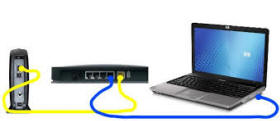| Internet & Networking |
|
Connecting to
the Internet and Surfing the Web
 There
are a few different ways for you to get online: DSL,
cable, or satellite. I have omitted dial-up because
very few folks use that any more. If you happen to be
one of those who do, I apologize. Drop me a line and
I'll add it back in. Moving on...
There
are a few different ways for you to get online: DSL,
cable, or satellite. I have omitted dial-up because
very few folks use that any more. If you happen to be
one of those who do, I apologize. Drop me a line and
I'll add it back in. Moving on...
How you connect to the internet depends on the computer you
have, how much you want to spend, and what's available in
your area. Home internet access requires a monthly
access fee and, depending on which you choose, the purchase
of new hardware.
DSL requires a special phone line installation and DSL modem while cable (and satellite) will simply come through your existing cable TV connection and connect to a cable modem. Your only job here is to choose a provider and make the call. Once you've contacted the provider they will (in most cases) send someone out with the proper equipment to get you set up while you eagerly wait. But what happens if they don't? Unlike ye old dial-up connections, the high-speed internet connections of today are really not very complicated.
Connecting the hardware
Once
you've decided on the provider you will get a DSL or Cable
modem from them. Simply connect the cable or DSL line from the wall to the
modem (it will likely have Cable or DSL printed where you
need to connect). Then connect the Ethernet cable (see
connections)
from the modem to your computer. (Unless you're using
wireless which we will discuss later.)
 You
may decide to set up your own home network and include more
than 1 computer, printer, scanner, etc. In this case,
may I suggest adding a router? This way you can share
files and printers in your home while keeping your info a
little safer with another layer of security you control.
To set up, connect from the wall to the service provider's
modem. Then connect an Ethernet cable from the modem
to your router. Finally, connect an Ethernet cable
(unless you're using wireless) to your computer. (see
image at left)
You
may decide to set up your own home network and include more
than 1 computer, printer, scanner, etc. In this case,
may I suggest adding a router? This way you can share
files and printers in your home while keeping your info a
little safer with another layer of security you control.
To set up, connect from the wall to the service provider's
modem. Then connect an Ethernet cable from the modem
to your router. Finally, connect an Ethernet cable
(unless you're using wireless) to your computer. (see
image at left)
*Note: I usually advise folks to connect in the order I have stated above. You can connect the power source to the modem and/or router both before you begin so they can do any power on tests and be ready. But when you begin your connections, start at the wall and work your way to the computer giving each device a few moments to start getting data before plugging in the next device.
Computer Setup
Once you've completed the connections above, turn on your
computer and give it a minute or two to detect the internet
connection. At this point you should be able to open
Internet Explorer (or whichever browser you choose) and be
connected to the internet. If not, please see the
troubleshooting page for internet.
![]()
The Beginning
Wizard of OS
Plug n Play
Internet & Networking
Care & Maintenance
Tips, Tricks & Tidbits
Troubleshooting
Tools & Info
Albums
Blog
Disaster101
Dugout
PC101
RambleCamp
Tip Jar
Contact
About
